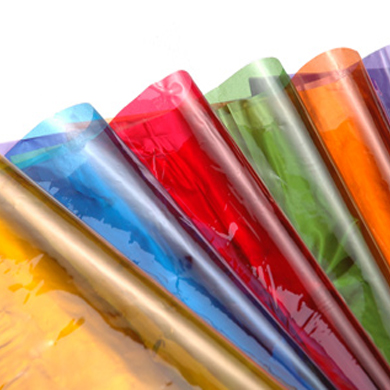Cellophane
Cellulose or cellophane, known under the former brand name cellophane ( Kalle & Co. AG, Wiesbaden, or the parent company, Hoechst AG, Frankfurt), is one of the oldest plastics for packaging that come directly into contact with food. It is a thin, colorless and transparent film of a regenerated cellulose with its characteristic " Cellophangriff " and crackling.
Cellophane is neither plastic nor elastically deformable and stretchable only in small sizes. However, cellular glass is a plastic that can be made fully from renewable instead of fossil fuels. The material composition resembles that of a viscose fiber.
Cellophane is impermeable to liquids but allows water vapor to pass through. This prevents appropriate packaging that forms inside condensation. To reduce the water vapor permeability of the cell glass, it is often not coated with other plastics. While thus giving it additional desired properties of regenerated cellulose film, but loses to environmental sustainability. For pure cellulose can be composted both also give the paper or burn. The coated film, however, is not completely biodegradable and should not be disposed of in waste paper.
History
Cellophane was invented in 1908 by the Swiss Jacques E. Brandenberger and marketed under the brand cellophane on the market. The name is derived from the raw material cellulose, and the ancient Greek word diaphanes (transparent). Until the 1950s, cellophane was practically the only packaging film. The fact that the packaged goods remained visible, helped pioneer the plastic to great success. Only after the Second World War was followed by a series of plastic films whose properties were to be determined much more marketable for their respective roles, including in particular polyvinyl chloride (PVC ), polyethylene (PE ), polypropylene (PP ) and polystyrene (PS).
Production
For the preparation of the cellulose hydrate from the so-called chemical cellulose wood pulp, a cellulose pulp, in aqueous sodium hydroxide (NaOH) and carbon disulphide ( CS2) is dissolved. The resulting viscous ( thick mixture ) is purified by means of filter presses and poured through a slit nozzle into a coagulation bath of dilute sulfuric acid, the cellulose precipitates. The resulting film is still soaked in the further course in several baths to remove residues of Glauber's salt formed in the coagulation bath (sodium sulfate). After passing through the last bath, the glycerin is added as a plasticizer, the film is dried on the heated rollers and then wound up.
The cost of production of regenerated cellulose are relatively high; only a few companies manufacture it today. The film can be printed or painted, they can be stuck and also thermally connect ( weld ).
Use
The more expensive cellophane preferred the cheaper plastic sheets - in the packaging industry is for certain goods and goods - because of the special micro-climate characteristics. To date, cigarettes and tobacco products, confectionery, baked goods, cheese, meat and some other foods, but also certain paper goods, medicines, clothing and flowers preferably packaged in cellophane held in plastic film. Also in the electrical industry, cellophane is used as an insulation ( capacitors, cables, tubes) still.
For some time it is also transparent cigarette paper, which is prepared by the same method as cellophane. In the early days of the hang glider in the early 1960s cellophane was used for the wing covering. Until the 1970s there was also scotch tape made of regenerated cellulose. Furthermore, cellophane is also used as a membrane material for dialyzers.
Ecology and Environment
The manufacture of regenerated cellulose requires a lot of resources such as timber, water, energy and air. The disposal of coated cellophane is not quite easy because it's not like uncoated cellophane compostable. Solely the use is so far without problems, where the requirements are strict regulations on the preparation of ( coated ) glass cell in the Commodities Regulation.










